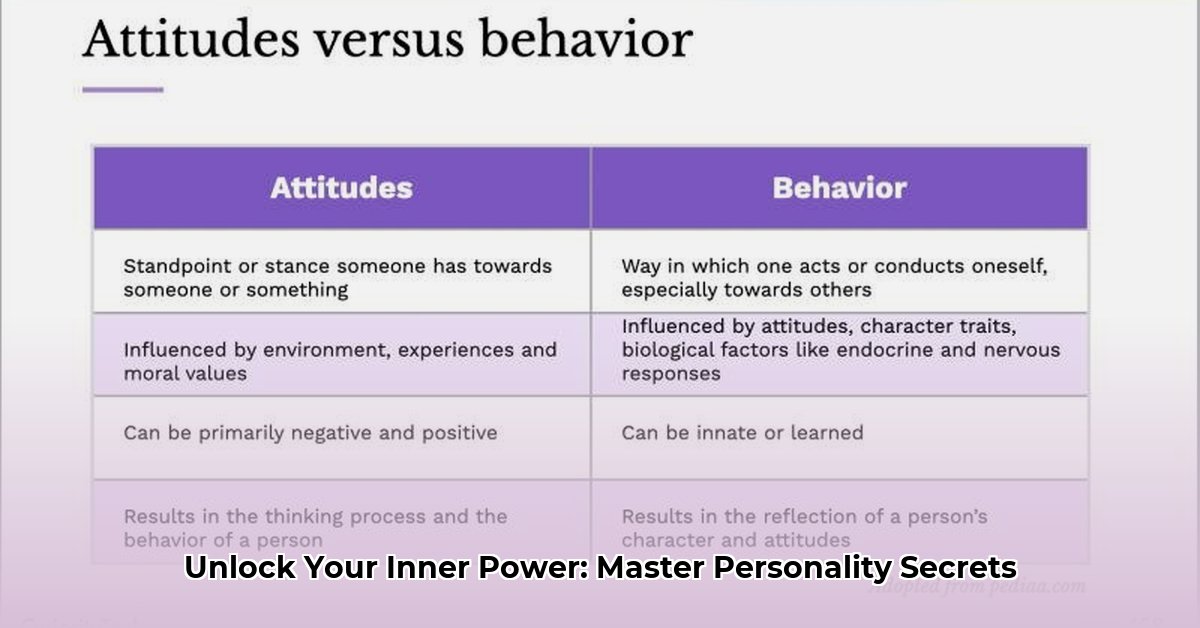
Personality vs. Behavior: Understanding the Dynamic Duo
Ever wonder why you sometimes act in ways that surprise even yourself? This guide unpacks the fascinating interplay between your personality—your inherent traits—and your behavior—your observable actions. We'll explore how these two elements interact, providing actionable strategies for personal and professional growth. This isn't about changing who you are fundamentally, but rather mastering the art of adapting your actions to achieve your goals.
Decoding Your Personality: The Engine Within
Your personality represents the core of who you are—your ingrained characteristics that influence your thoughts, feelings, and behaviors. Think of it as your internal blueprint, relatively stable over time. Are you introverted (preferring solitude) or extroverted (energized by social interaction)? These are personality traits, influencing how you perceive and react to the world. However, they are not fixed; they are tendencies that can be subtly modified.
Several models, such as the Big Five personality traits (openness, conscientiousness, extraversion, agreeableness, and neuroticism), help categorize these tendencies. But remember, these are simplifications of a complex human experience. Research continually refines our understanding of personality development.
"Personality is a complex interplay of genetics, environment, and life experiences," explains Dr. Anya Sharma, Professor of Psychology at Stanford University. "It’s less about rigid categories and more about understanding your inherent tendencies."
Understanding Your Behavior: Actions in Context
Behavior, however, is what you do. It’s your observable actions and reactions in specific situations. You might be generally shy (a personality trait) yet deliver a captivating presentation (a behavior). Your personality sets the stage, but your behavior is your performance, shaped by context and goals.
Different psychological perspectives offer varying explanations for behavior. Behaviorism emphasizes learning and environment, while cognitive psychology highlights thought processes. The interplay between personality and behavior is not always straightforward; it's a dynamic interaction.
The Dance Between Personality and Behavior: A Practical Guide
Your personality and behavior are not static; they constantly interact and influence each other. Your personality predisposes you to certain behaviors, but the situation profoundly impacts your actions. A normally calm person might react aggressively in a stressful situation – the context overrides their typical personality.
Bridging the Gap: Actionable Steps for Self-Discovery
Understanding this interplay is key to personal growth. Here's a practical framework:
Step 1: Assess Your Personality: Gain a clearer view of your personality traits. Online personality tests can be helpful starting points, but self-reflection is equally crucial. What are your strengths and weaknesses?
Step 2: Observe Your Behavior: Pay close attention to your actions in various situations. Journaling can be invaluable: record situations, your responses, and your feelings. This reveals patterns and triggers. Do you find yourself behaving differently at work than at home?
Step 3: Strategically Adjust Behaviors: Identify behaviors inconsistent with your goals. This doesn't involve personality transformation; it's about mindful behavioral adjustments. Small changes accumulate significant results.
Step 4: Embrace Adaptability: Rigid adherence to specific behavioral patterns is unproductive. Aim for mindful adjustments based on context. This requires flexibility and self-compassion.
Step 5: Seek Professional Guidance (When Needed): If you struggle with specific behaviors, consider professional help. A therapist can provide tailored strategies and support.
How to Change Negative Personality Traits Affecting Workplace Behavior
Let's face it: we all have flaws. Negative personality traits can hinder professional success. This section provides tools to address such challenges, focusing on behavioral modification rather than complete personality transformation. This is about becoming a better version of yourself, not a completely different person.
Identifying Workplace Challenges
Pinpoint the behaviors stemming from negative traits. Are you overly critical? Do you struggle with teamwork? Honest self-reflection is crucial. Utilize journaling to track patterns, identifying behaviors hampering productivity and relationships.
Strategies for Positive Change
Employ these strategies:
Mindfulness & Self-Regulation: Practice mindfulness to increase awareness of thoughts and reactions. This enhances impulse control and prevents negative behaviors.
Optimism & Growth Mindset: Develop an optimistic outlook; view challenges as growth opportunities. Frame setbacks as learning experiences.
Goal Setting & Action Planning: Break down goals into manageable steps. This approach reduces overwhelm and promotes a sense of accomplishment.
Seeking Support: Utilize colleagues, mentors, or therapists to receive an objective perspective and support.
A Seven-Step Framework for Change
- Identify the problem: What negative trait hinders your work performance?
- Understand the root cause: Why do you exhibit this trait?
- Set realistic goals: Specify the changes you want to achieve.
- Develop strategies: Outline actions supporting these goals.
- Seek support: Identify individuals for accountability.
- Track your progress: Monitor your improvements and adjust strategies accordingly.
- Celebrate successes: Reward yourself for your efforts.
Long-Term Transformation: Consistency is Key
Remember, changing ingrained tendencies requires consistent effort. Celebrate small victories and maintain focus on progress—not perfection. The goal is not complete trait eradication but effective behavior management.